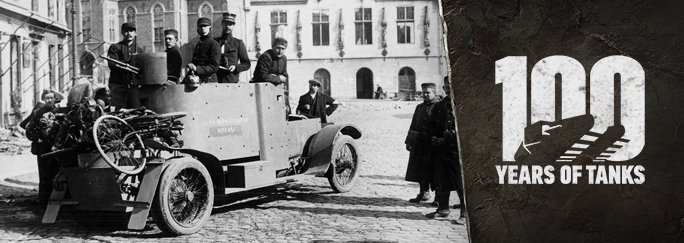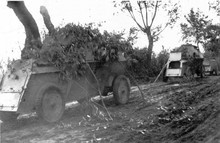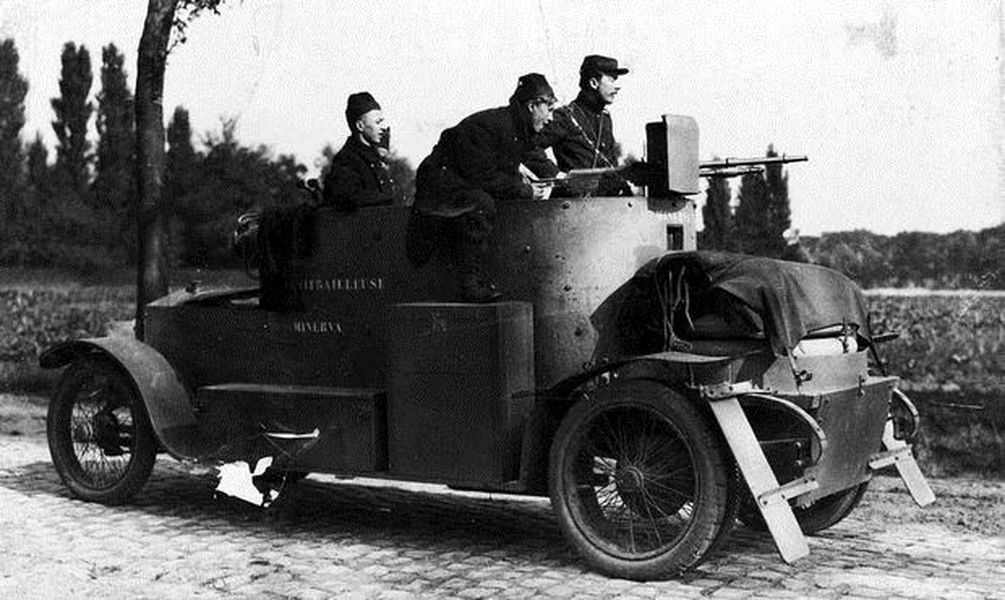100 Years of Tanks: Wheeled Brothers

Wheeled armoured vehicles presented an alternative to combat vehicles on tracks. However, they had to travel a long and winding way to the battlefield. These vehicles had to cut through mud, numerous shell holes and plenty of other obstacles, typical of trench warfare.
Starting from February 1915, the engineers from the Landship Committee were looking for a "wonder weapon" for the British Army—a self-propelled armoured vehicle. The months of hard work did not result in any success and it seemed that the British Admiralty gave up on this promising concept, since no one could come up with a worthy project.
However, there was another product of technical development that was already implemented several years ago and even had received its baptism of fire by 1915. These were wheeled armoured vehicles—close relatives the soon to be developed tank. These vehicles were first used in warfare at the turn of the 20th century. As is often the case with new military advancements, many military officers considered them to be nothing more than a novelty. That is why quite a significant period of time passed before the first units of armoured vehicles were adopted by European militaries. However, the first armoured vehicles generally did take part in the battles of World War I, on both the Western and Eastern fronts.
Minerva Military Armoured Cars: the First Division of Armoured Vehicles on the Western Front
In 1914, Belgium was to face the nightmare reality of World War I. It was during the German invasion of Belgium that officer of the General Staff, Lieutenant Charles Henkart used his civilian Minerva automobile to get to the front line. To reach the battle safe and sound, this witty Belgian arranged his car to be protected with armour plates and equipped with an 8-mm Hotchkiss machinegun. Thus, the ancient goddess of wisdom was fully equipped and ready to fight. This vehicle proved to be quite effective: its high speed of up to 90 km/h (on asphalted roads) allowed for quick and successful attacks on German positions. Unfortunately, later the armoured car was caught in a German ambush and destroyed.
|
Despite Henkart's innovation proving to be successful, it was not duly appreciated by military command. However, the Belgium military attaché in Paris, Major Auguste Colonne, was more successful in his attempts: he managed to establish a fully-equipped division of armoured vehicles in the late autumn of 1914. They featured the Minerva and Peugeot armoured cars equipped with 37-mm guns and machine guns. The combat weight of some of these vehicles was up to 4 tons, with the crew including a commander, gunner, driver and driver's assistant. |
|
This Belgian armoured brigade also had an independent repair service and bicycle units. Major Colonne considered his project an elite unit. He even ordered a separate uniform from a Parisian couturier and preferred enlisting servicemen mainly from the aristocracy. There were some exceptions, however, such as the charismatic soldier, Constant le Marin, who was the supposed author of the famous battle cry "We will cut their heads off", which was later shouted even on the Russian front. Another example of a remarkable person was the 18-year old poet Marcel Thiry, who entered the unit to “have some fun and make a contribution in a historic battle”.
The unit was going through trials until the spring of 1915 in Boulogne and later was redeployed in Flanders. But only numerous fields, pock-marked with shells and poisoned with mustard gas lay ahead, and the Belgian unit of armoured cars had few opportunities to contribute to the combat. The reality of trench warfare made the Minerva military armoured cars useless.
Armoured Life Savers From Great Britain
The history of the Royal Naval Armoured Car Division was similar. In the beginning, Great Britain established its own Royal Navy Air Service. After the beginning of World War I, British forces started using airplanes for reconnaissance. However, many aircraft never came back, and the rescuing of pilots was considered their primary objective. This mission was entrusted to the crews of Lanchester armoured cars, which were developed on the request of the RNAS. These vehicles were protected by 8-mm armour plates and mounted a 7.62-mm Maxim or 7.7-mm Lewis machinegun.
The commander of the division was quite a remarkable person—Oliver Locker-Lampson, the Conservative representative in the British House of Commons. Like his Belgian counterpart, he also transformed his Rolls-Royce into an armoured car. In fact, the wages of the drivers of armoured cars was an issue that almost provoked a quarrel between the Secretary of State for War Horatio Kitchener and the First Lord of the Admiralty Winston Churchill. As a matter of fact, a common army driver had a wage of 6 shillings per day, while Locker-Lampson provided his drivers with a wage of 10 shillings.
The division of British armoured cars was sent to the front in Flanders and like their Belgian colleagues did not prove their worth during military operations. According to historian Jaroslav Galubinov: “Despite the fierce battles against the German troops in Flanders, the division did not prove its worth. Those manoeuvrable armoured cars were useless in positional warfare, where the battlefield was crossed with numerous and endless lines of trenches."
The Allies could not afford to maintain two battle-ready divisions that were unsuitable for action on the front. Soon after, the decision was made to send the divisions of armoured cars to the Russian Empire, where the 1st automobile machinegun platoon was formed.
"Adsky" and "Grozny" Horse-borne Armoured Vehicles
The Russian Empire was a major innovator when it came to the creation of the first automobile machinegun units. Back in 1906, M. A. Nakashidze came up with the idea for such a unit. Unfortunately, he was killed during a bomb explosion and was never able to fulfil his plans.
In August 1914, the Secretary of War V.A. Suchomlinov approved the creation of an "armoured automobile machinegun platoon". The same year, in October, this platoon was sent to the North-Western front, under the command of Regiment Colonel A.N. Debrzhansky. At the time, the platoon contained armoured vehicles based on the chassis of Russo-Balt light cars. The vehicles had 5 crew members and were equipped with 3 Maxim machine guns each. Later, additional vehicles were purchased and the 1st automobile machinegun platoon received several Austin 1st series British armoured cars.
 The warfare of 1914 proved that armoured vehicles could not rely solely on the firepower of machine guns, but that larger calibre weapons were also necessary. Soon, the development of the first armoured vehicle to mount both a machine gun and a larger weapon, mounted onto the body of the American 5-ton Garford carrier, began.
The warfare of 1914 proved that armoured vehicles could not rely solely on the firepower of machine guns, but that larger calibre weapons were also necessary. Soon, the development of the first armoured vehicle to mount both a machine gun and a larger weapon, mounted onto the body of the American 5-ton Garford carrier, began.
Armoured vehicles on the Russian front were more effective and more widely-used compared to their counterparts on the Western front. According to witnesses at the time: "We noticed some creepy silhouettes, which paid no attention to the hail of bullets that were buzzing everywhere. The grim sound of creaking—and the first continuous rows of helmets moved forward, then another and another... the dreadful creepy gray silhouettes came closer and closer, and the stinging showers of cold lead pierced through the columns of German soldiers. Soon, the "Hurrah!" cry of Russian soldiers rumbled through the centre of the town". That is how witnesses described the offensive of the "Russo-Balt" armoured cars on 10 November, 1914 in the town of Stryków. Two years later, the trial by fire of the first tanks would result in the same emotions.
As a rule, each armoured car in the Imperial Russian Army received its own name. For example, in the late Autumn of 1915, the Austin 1st series armoured car "Adsky" and the Garford armoured car "Grozny" were reported as securing an infantry crossing point. At the time, German forces could do little to respond to the threat of these vehicles.
By this stage, a total number of 120 armoured vehicles had been successfully used on Russian fronts where there were more opportunities to conduct mobile warfare. However, these armoured vehicles still necessitated roads suitable for motor vehicles. Snowfall and the spring season often resulted in extremely poor road conditions, passable only by hanging chains on the wheels.
But those were not the only problems with using armoured cars: they were noisy—the advancing vehicles easily detected by the sound of their engines, and they were often too heavy to cross less sturdy bridges and makeshift crossings. For these reasons, some commanders refused to use them in combat.
The Locker-Lampson armoured vehicles fought on the Caucasian and Romanian fronts, as well as taking part in the last offensive of the Imperial Russian Army in June, 1917, in Greece. It turned into a disaster. From the memories of one division officer: "The attack was followed by the counterattack with gas, flame guns and other dirty tricks of vandals. Our comrades held our positions but were not able to advance". By 1918, the units had left their iron horses on the fields of Kursk and Vladivostok and had returned home.
World War I proved to be a difficult challenge for armoured vehicles on all fronts. It started with a period of mobile warfare during which armoured units could play a leading role. However, in the summer of 1915, the war became mired in the quagmire of trench warfare, negating their one great advantage—their manoeuvrability. At this critical moment, the British war correspondent Cornell Ernest Dunlop Swinton sent a letter to the Commander of British Forces in France, Field Marshal John French. According to it, it was "necessary to develop new combat vehicles, on the basis of gasoline tractors on tracks".
No one expected that this seemingly insignificant letter would turn the course of history.
Sources:
- Boyen R. The division of Belgian armored cars in the Imperial Russian Army // The last war of the Russian Empire: Russian Empire, the world before, during and after the World War I according to documental sources from Russian and foreign archives. M., 2006. P. 226–232.
- Kirilets S. V., Kaninsky G. G. Combat vehicles in the Imperial Russian Army. «Combat vehicles academy» of General Sekretev. М., 2010.
- Kolomiets M. V. Armored combat vehicle division in the Imperial Russian Army // Russian Empire in the World War I in 1914–1918: Encyclopedia. В 3 v. T. I. М., 2014. P. 212–221.
- Popova S. S. Trials of Belgium soldiers in the Russian Empire // War-historical journal. 1996. No 2. P. 46–52.







